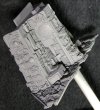Former1
New Member
- Joined
- Jun 2, 2023
- Messages
- 452
Love my Iwata Eclipse!!!
I will give it a shot! I have one of this vortex paint mixers, so mixing it is easy


Ok the Stynylrez primer arrived today. I put the .6 in the Paasche Raptor, turned the compressor up to 35 and put a few drops of flow improver in first. Than the primer. I have to say I am impressed. This is maybe 10 minutes after the initial spray.
Clean up was easy too.
Yeah I had just ordered a 2oz of the black to try it out. Now I have ordered the white, gray, and black gloss
Thanks for the tip! I am using it on my next kit. I have a "paint mule" I will test thinning on.I find the white to be the most problematic. Requires a bit of thinning for me…
Thanks for the tip! I am using it on my next kit. I have a "paint mule" I will test thinning on.
this next kit will be interesting. It is the old F3F-3 Wildcat early version. The one with the yellow wings. SO I am going to try two different primers. White on the yellow wings and gloss black on the aluminum body. but I am testing on the mule first.Paint mules are a good thing to have around!
Personally I think an airbrush is essential for serious scale modeling. Granted I only say that because I prefer to use it. In regards to the spiderwebbing, Do you have a moisture tap?This post is honestly not a troll. I know people have strong opinions about their airbrushes.
I have two:
My first was a Neo CN for Iwata. It is fine. I use it for lower PSI stuff, clear coats, and primer sometimes.
I picked up a Paasche Raptor with 3 needles .25, .38, and .66. It is good! I like that it is American made, and that I can replacement parts from my local model shop.
I still struggle with both clogging and spider webbing. I think this is because I just need to experiment more, and learn more about paints and thinning. but I am also considering if I invested in a higher quality airbrush, I might have more luck. I use Vallejo acrylics most of the time if that makes a difference.
I am comparing the Iwata Eclipse Series, and the Harder and Steenbeck Evolution 2 in 1. I like the idea of having multiple needle options in one airbrush, and Iwata kind of hides the precise needle sizes.
Part of me thinks I should "learn to play tennis with a wooden racquet" as my dad used to say. Meaning, using fancy tools can hide flaws in your basic technique.
Anyway, I welcome your thoughts. I don't really have a question here except maybe, when do you update your airbrush? and what do you recommend?
I do! Mine sits between the compressor and air hose. When do you press the button on the bottom to vent the moisture? I usually do it when I am done airbrushing for the day to clean the air out of my tankPersonally I think an airbrush is essential for serious scale modeling. Granted I only say that because I prefer to use it. In regards to the spiderwebbing, Do you have a moisture tap?
Personally I think an airbrush is essential for serious scale modeling. Granted I only say that because I prefer to use it. In regards to the spiderwebbing, Do you have a moisture tap?
I watch their videos all the time! I think they ae great. I used to brush paint everything. Since getting an airbrush I have stopped. But I still like the videos
I was thinking that that might be the reason for the spiderwebbing. I would recommend starting up your air compressor, flushing out the moisture out, and then using your airbrush (with no paint in it). Just let it run for a little bit. Sometimes with really high humidity small droplets of water can get stuck in the compressor or airbrush hose.I do! Mine sits between the compressor and air hose. When do you press the button on the bottom to vent the moisture? I usually do it when I am done airbrushing for the day to clean the air out of my tank
While I do respect this individuals work, I also only have limited time in the day. Brush painting is rather slow.
I was thinking that that might be the reason for the spiderwebbing. I would recommend starting up your air compressor, flushing out the moisture out, and then using your airbrush (with no paint in it). Just let it run for a little bit. Sometimes with really high humidity small droplets of water can get stuck in the compressor or airbrush hose.
While I do respect this individuals work, I also only have limited time in the day. Brush painting is rather slow.
Plus, as can be seen in this video, techniques like color modulation are much easier with airbrushes.
